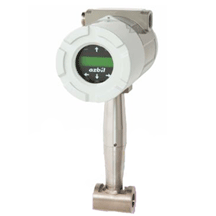
Multivariable Vortex Flowmeters
Model AX2 _ _ _
Model AX2_ _ _ Multivariable Vortex Flowmeters incorporate azbil Group proprietary technologies and are multivariable and insertable. They measure flow rates of various fluids including liquid, gas, and steam, over a wide range of temperatures from -200 to +400 °C. These multivariable vortex flowmeters make highly accurate measurements of the flow rate of gas and superheated steam in particular.
Multivariable functionality is achieved by three built-in sensing elements, a vortex shedding flow velocity sensor, a pressure sensor, and a temperature sensor. Because they measure flow rate, fluid temperature, and fluid pressure, these flowmeters can measure the mass flow rate of various fluids including gas, liquid, and steam, by means of density compensation. In addition, because they are insertion type, these flowmeters can be attached and detached without stopping the process, thereby lowering operating costs by reducing downtime.
Inline type, insertion type
- For improved measurement efficiency and lower costs, this single unit provides the functions of four devices, flowmeter, pressure transmitter, temperature transmitter, and mass flow rate computing unit, and can output a selection of three items from among volumetric flow rate, mass flow rate, temperature, pressure, and calculated density.
- The density compensation function based on the measurement of temperature and pressure allows a highly accurate measurement of the mass flow rate.
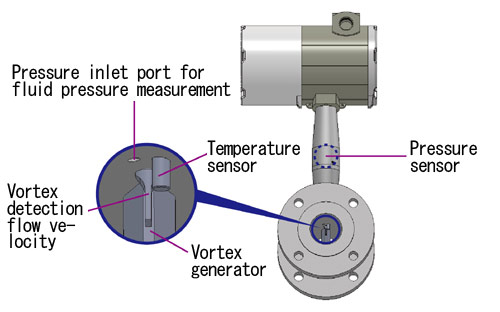
Internal Structure of AX2_ _ _ Multivariable Vortex Flowmeters
Insertion type
- Even with a large pipe diameter, these insertion flowmeters can measure flow rates at a low cost.
- Combined use with a gate valve allows maintenance without stopping the process.
- Since flowmeters can be installed regardless of pipe diameter, it is not necessary to have different devices for different pipe diameters, which considerably reduces the need to stock spares.
Value offered by multivariable function
Value offered by insertion type
Value offered by multivariable function
A single unit fulfills 4 roles!
Density compensation for the fluid is done by measuring its temperature and pressure. This makes it possible to measure with high accuracy the mass flow rate of superheated steam or of a gas whose density changes depending on the temperature and pressure.
Since a single unit can measure and output flow rate, temperature, and pressure, in a process that measures these three variables it is not necessary to install and wire multiple devices, allowing a reduction of the overall cost.
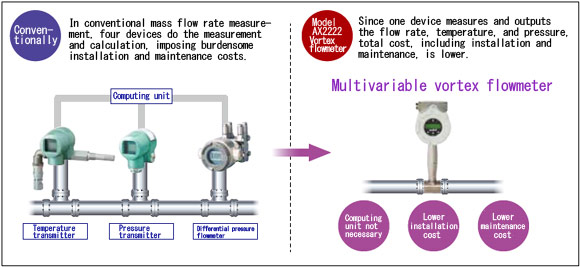
Excellent density compensation function based on temperature and pressure
Here, the density calculation formula based on the Boyle-Charles method (the formula used for the density compensation of ordinary gas) and that employed by this flowmeter are compared.
The density calculated by the Boyle-Charles method and the density calculated by the formula used by this flowmeter are compared by taking superheated steam at 320 °C as an example and assuming the value listed on the superheated steam table to be the true value.
This shows that the density calculated by this flowmeter is a good match with the density in the superheated steam table.
As the pressure increases, the density calculated by the Boyle-Charles method increasingly deviates from the density in the superheated steam table (Figure A.)
Figure B shows the error in densities calculated by this flowmeter and by the Boyle-Charles method relative to the density in the superheated steam table. This error contributes to the mass flow rate accuracy error.
This flowmeter can accurately measure the mass flow rate because it is does so based on a correct density calculation, and therefore it can measure the mass flow rates of various superheated steams and gases.
■ Density of superheated steam at 320 °C (Figure A)
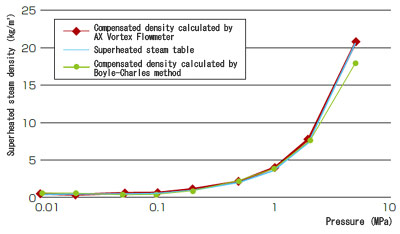
■ Difference (%) from density in superheated steam table at 320 °C (Figure B)
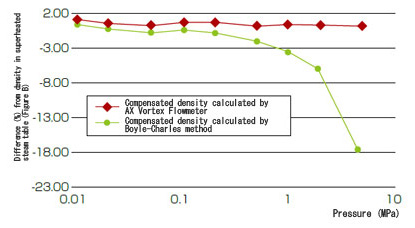
Value offered by insertion type
Maintenance without stopping ongoing processes (packing gland type)
(1) During use in process line
To use the flowmeter during operation, open the gate valve to be used in combination and then insert the sensor head into the piping.
(2) Pull up sensor head.
To conduct a check or maintenance of the flowmeter, first turn the handle and then pull up the sensor head.
(3) Close gate valve and perform maintenance.
With the sensor head pulled up and gate valve full open, do the check or maintenance of the flowmeter.
After the check/maintenance, conduct a leak check, put the sensor head back by following the procedures in reverse order, and the resume operation.
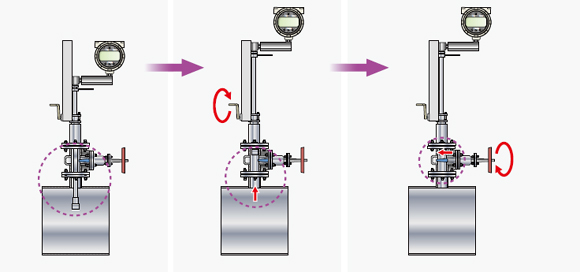
Same price also for large bore, contributing to cost reduction
The outer dimensions and mass of the inline type vary in proportion to square of the bore diameter, which is reflected in its cost.
A single insertion type flowmeter can be installed in piping with varying bore diameters because the insertion length can be changed. Insertion type flowmeters can therefore be offered at the same price regardless of the applicable bore diameters. As the bore diameter increases, the advantage of the insertion type in terms of cost over the inline type becomes greater. (Applicable to bore diameters of 50 mm to 1,800 mm.)
| Inline type | Structure-based price comparison |
|---|---|
 |
Structure/bore-based relative price relative to a flange connection (JIS10k, 50 mm) price set as 1.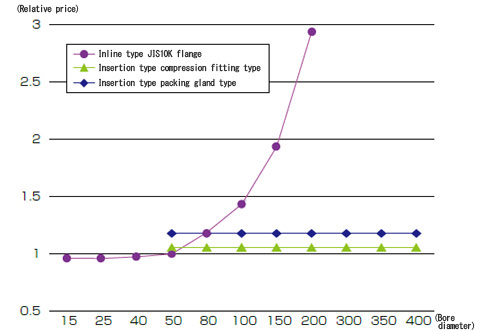 |
| Insertion type | |
 |
Significant reduction in spare devices
The inline type requires multiple spare parts according to the piping bore and pressure rating.
When using the insertion type, a single flowmeter can measure bore diameters of 50 mm to 1,800 mm regardless of the piping bore or pressure rating because the insertion length can be changed. Also, only a single unit need be prepared as a spare since measurement of liquid, gas and steam is possible by changing the internal setting for fluid types to which this flowmeter is applicable.
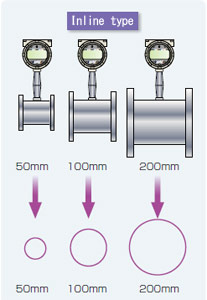
Multiple spare devices are necessary.
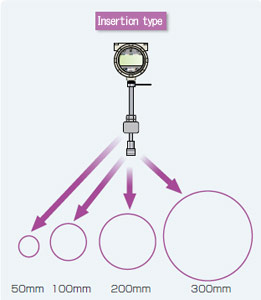
A single unit can be applied to various bores.
Lower installation costs
Since the temperature in steam pipes where a vortex flowmeter is used is high in many cases, flowmeters are often installed in high places. This requires costs for operating a high elevation work vehicle and installing a scaffold. For large diameter piping in particular, there is a big difference between the use of inline flowmeters and the use of insertion flowmeters in terms of installation work costs.
Sample comparison of work costs in Japan (for diameter 300 mm)
US$
| Item | Inline type | Insertion type |
|---|---|---|
| Work costs | 1,500 | 500 |
| Costs for operating a high elevation work vehicle | 1,500 | 0 |
| Cost for piping material | 800 | 200 |
| Cost for scaffold installation | 1,000 | 1,000 |
| Total | 4,800 | 1,700 |
